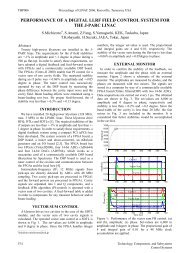Design and Development of a Diagnostics Client for a Beam Loss ...
Design and Development of a Diagnostics Client for a Beam Loss ...
Design and Development of a Diagnostics Client for a Beam Loss ...
You also want an ePaper? Increase the reach of your titles
YUMPU automatically turns print PDFs into web optimized ePapers that Google loves.
<strong>Design</strong> <strong>and</strong> <strong>Development</strong> <strong>of</strong> a <strong>Diagnostics</strong> <strong>Client</strong> <strong>for</strong> a <strong>Beam</strong> <strong>Loss</strong> Measurement System at CERN<br />
The last <strong>and</strong> very important group <strong>of</strong> settings is the storage group. It consists <strong>of</strong> a button,<br />
a small text field <strong>and</strong> a checkbox. It is shown in Figure 20. A user should utilize the check<br />
box to select whether or not to save the incoming data into binary files. The path used <strong>for</strong><br />
the logging process is displayed in the text field. This path is specified by the user, who<br />
must press the directory button, so that a pop-up window with a Folder-Chooser appears<br />
<strong>for</strong> path selection.<br />
All <strong>of</strong> the a<strong>for</strong>ementioned parameters should be set be<strong>for</strong>e starting a new acquisition ses-<br />
sion. In the actions group <strong>of</strong> the GUI the Start <strong>and</strong> Stop buttons exist. A control check<br />
<strong>of</strong> the values <strong>of</strong> the parameters should be initiated be<strong>for</strong>e establishing a connection with<br />
the BLEDP server. If a parameter is wrongfully or not set <strong>and</strong> the user presses the Start<br />
button, an error pop-up window appears.<br />
Most <strong>of</strong> the important parameters have default values, in case it is the first time that the<br />
client executes on a computer. If it has been executed more than once on the same<br />
computer, then the application “remembers” the settings <strong>of</strong> the last time. This feature is<br />
achieved with the help <strong>of</strong> a class named PersonalSettingsManager. This class makes use<br />
<strong>of</strong> a HashMap <strong>and</strong> a binary file, where the latest values <strong>of</strong> many Swing components are<br />
stored. The directory where this binary file is stored, depends on the operating system on<br />
which the client is running. Furthermore, it is obvious that different binary files are stored<br />
<strong>for</strong> different users <strong>of</strong> the client.<br />
4.4.2.1 <strong>Design</strong> implementation <strong>of</strong> the online interface<br />
In general, the online panel is h<strong>and</strong>led by a class named OnlineDataViewerGUI. This class<br />
creates <strong>and</strong> h<strong>and</strong>les all the panels <strong>and</strong> the components inside them using several swing<br />
layout managers, i.e. FlowLayout, GridLayout, GridBagLayout <strong>and</strong> BorderLayout. It also<br />
contains several action listeners <strong>and</strong> event-h<strong>and</strong>ling methods <strong>for</strong> the different components<br />
<strong>and</strong> manages every control check <strong>of</strong> the parameter values be<strong>for</strong>e initiating the communi-<br />
cation with the embedded server. Also, the main method <strong>of</strong> the application is part <strong>of</strong> this<br />
class.<br />
The Swing event h<strong>and</strong>ling code runs on a special thread known as the event dispatch<br />
thread (EDT). Most code that invokes Swing methods also runs on this thread. This is nec-<br />
essary because most Swing objects methods are not “thread safe”, so invoking them from<br />
multiple threads risks thread interference or memory consistency errors. It’s useful to think<br />
<strong>of</strong> the code running on the event dispatch thread as a series <strong>of</strong> short tasks. Most tasks are<br />
invocations <strong>of</strong> event-h<strong>and</strong>ling methods, such as ActionListener.actionPer<strong>for</strong>med. Other<br />
tasks can be scheduled by application code, using invokeLater or invokeAndWait. Tasks<br />
on the event dispatch thread must finish quickly; if they don’t, unh<strong>and</strong>led events back up<br />
<strong>and</strong> the user interface becomes unresponsive. [12] In our case, we need to execute a<br />
long-running task, which is the communication with the server <strong>and</strong> then data acquisition,<br />
processing, logging <strong>and</strong> plotting. We have to use a background worker thread <strong>for</strong> that<br />
Emmanouil I. Angelogiannopoulos 34















